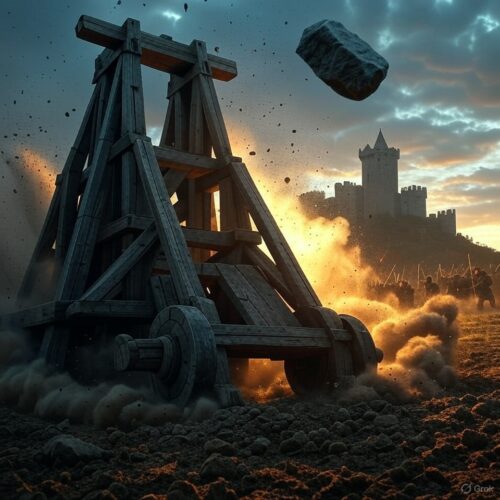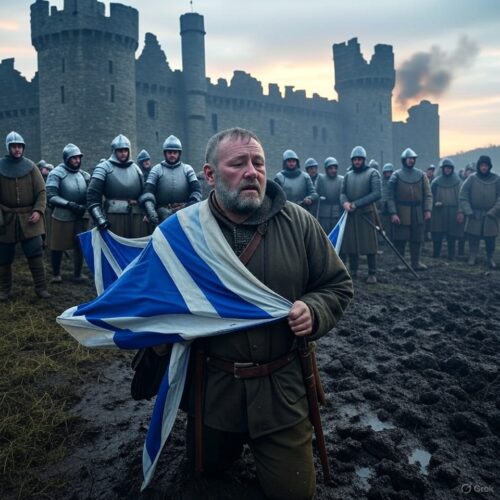## Introduction: A Roaring Echo from the Past
Imagine a towering wooden giant, creaking and groaning as it hurls massive stones through the air, shattering stone walls and the resolve of those behind them. On July 24, 1304, such a scene unfolded at Stirling Castle in Scotland, where the Fall of Stirling Castle marked a turning point in the Wars of Scottish Independence. At the heart of this dramatic siege was the War Wolf, a colossal trebuchet that didn’t just break defenses—it broke records as one of the largest siege engines ever built. This wasn’t just a battle of swords and shields; it was a clash of ingenuity, determination, and raw power.
Today, we’re diving deep into this fascinating event from distant history, unearthing the gritty details of medieval warfare and uncovering lessons that can catapult us forward in our own lives. This isn’t your average history lesson—it’s a journey through time that’s as educational as it is thrilling, with a dash of motivation to inspire you to conquer your own castles. Let’s storm the gates of the past and see what treasures we can bring back to the present!
—

## Historical Context: Scotland’s Fight for Freedom
To fully appreciate the Fall of Stirling Castle, we need to step back into the chaotic world of late 13th and early 14th century Scotland. The year was 1286, and Scotland’s King Alexander III took a fateful tumble from his horse, leaving no surviving children to inherit the throne. His only heir, his granddaughter Margaret, known as the Maid of Norway, was just a child living far across the sea. When she died in 1290 at the tender age of seven, Scotland was thrown into a succession crisis that would ignite decades of conflict.
Enter King Edward I of England, a towering figure both literally and figuratively, nicknamed “Longshanks” for his impressive height. Edward saw Scotland’s turmoil as a golden opportunity to extend his influence northward. In 1292, he intervened in the succession dispute, installing John Balliol as a puppet king under English overlordship. But the Scots weren’t keen on bending the knee. By 1296, tensions boiled over, and Edward invaded, deposing Balliol and claiming Scotland for himself. What followed was a fierce resistance led by a rugged warrior named William Wallace.
Wallace’s stunning victory at the Battle of Stirling Bridge in 1297 sent shockwaves through England. With a ragtag army, he ambushed English forces crossing the narrow bridge over the River Forth, proving that Scotland wouldn’t go down without a fight. But Edward was relentless. After Wallace’s defeat at Falkirk in 1298 and his eventual execution in 1305, English control tightened. By 1304, most Scottish nobles had submitted to Edward, leaving only a handful of strongholds defying his rule.
Stirling Castle was one such holdout. Perched atop a volcanic crag overlooking the River Forth, it was a natural fortress and a strategic linchpin. Controlling Stirling meant controlling the gateway between the Scottish Lowlands and Highlands. For Edward, capturing it was the final step in crushing Scottish resistance. For the Scots, it was a last stand against domination. The stage was set for a showdown that would echo through history.
—

## The Siege of Stirling Castle: A Battle of Brains and Brawn
The siege began in April 1304, with Edward I personally commanding an English army of about 7,000 men. This wasn’t just a military campaign—it was a spectacle of royal determination. Edward, now in his sixties, was a seasoned warrior king who’d earned his reputation through brutal campaigns in Wales and beyond. His forces included heavily armored knights, skilled archers, and a team of engineers whose ingenuity would steal the show.
Defending Stirling Castle was Sir William Oliphant, a resolute Scottish knight leading a tiny garrison of around 30 men. The castle’s towering walls and elevated position made it a tough nut to crack, but Oliphant’s crew was pitifully small compared to the English horde. They had grit, stone walls, and little else—no reinforcements, dwindling supplies, and a growing sense of isolation. Yet they held firm, determined to make Edward pay for every inch.
For three months, the English hammered the castle with a barrage of medieval firepower. Catapults lobbed stones** **stones, battering rams thudded against gates, and archers rained arrows on the battlements. But Stirling’s defenses held. The walls, built from the local volcanic rock, shrugged off the assault. Edward, growing impatient, decided it was time to escalate. He turned to his secret weapon: a team of engineers and a blueprint for something extraordinary.
### Enter the War Wolf: The Beast That Shook the Earth
Midway through the siege, Edward ordered the construction of the War Wolf, a trebuchet so massive it defied belief. This wasn’t your garden-variety catapult. Historical accounts describe it as a behemoth, requiring 30 wagons to haul its disassembled parts from England to Scotland. Once assembled, it towered over 300 feet high, with a counterweight system that could sling stones weighing up to 300 pounds over 200 yards. The name “War Wolf” wasn’t just for show—it was a snarling, mechanical monster designed to tear down walls and break spirits.
Building the War Wolf was a feat of medieval engineering. Craftsmen worked tirelessly, assembling massive wooden beams, ropes thicker than a man’s arm, and a counterweight system that harnessed gravity’s might. The design likely drew inspiration from trebuchets used in the Crusades, refined to a scale never seen before. It took weeks to complete, with Edward overseeing every detail, eager to unleash his masterpiece.
When it was ready, the War Wolf roared to life. Its first shot was a spectacle—a boulder crashed into the castle wall, sending chunks of stone flying and a ripple of dread through the defenders. The psychological impact was as devastating as the physical damage. The Scots, already worn down by months of siege, saw their impregnable fortress begin to crumble.
—

### The Fall: A Dramatic Finale
With the War Wolf operational, the end came swiftly. The Scots sent envoys to negotiate surrender, their morale shattered by the relentless bombardment. But Edward, ever the showman, refused. He wanted to see his War Wolf in full glory. For days, the trebuchet pounded the castle, reducing towers to rubble and turning courtyards into craters. Chroniclers say the noise was deafening—a symphony of cracks, thuds, and screams that echoed across the Forth Valley.
Finally, on July 24, 1304, Sir William Oliphant raised the white flag. The garrison, battered and broken, surrendered unconditionally. Edward marched in triumphantly, claiming Stirling Castle as his prize. The War Wolf had done its job, cementing its place in history as a game-changer. For the Scots, it was a bitter defeat, but their spirit wasn’t extinguished—Robert the Bruce would rise a decade later to reclaim independence at Bannockburn.
The siege showcased Edward’s strategic brilliance and ruthless ambition, but it also highlighted the Scots’ tenacity. Stirling Castle’s fall didn’t end the war; it was a chapter in a longer saga of resilience and rebellion.
—

## Lessons from the Siege: Wisdom Forged in Stone and Steel
The Fall of Stirling Castle isn’t just a tale of war—it’s a treasure trove of lessons we can carry into our modern lives. Here’s what this epic clash teaches us:
- **Preparation is Power**: Edward’s victory hinged on planning. He brought an army, yes, but also the resources and expertise to build the War Wolf. Success doesn’t happen by accident—it’s built, step by step.
- **Innovation Breaks Barriers**: The War Wolf wasn’t a standard weapon; it was a bold leap forward. When the usual tactics failed, Edward’s engineers rewrote the rules. Innovation can turn the impossible into the inevitable.
- **Persistence Pays Off**: The Scots held out for three months against insane odds, and Edward kept pushing until he won. Both sides showed that grit can carry you further than you think.
- **Mind Games Matter**: The War Wolf wasn’t just about destruction—it was a psychological battering ram. Understanding how perception shapes outcomes can give you an edge in any battle.
- **Know Your Limits**: Edward’s refusal to accept surrender until he’d flexed his War Wolf’s muscles prolonged the fight unnecessarily. Sometimes, winning gracefully is smarter than winning big.
These lessons aren’t stuck in 1304—they’re alive and kicking, ready to help us tackle today’s challenges.
—
## Applying the Past to Your Present: A Plan for Victory
So, how do you take a medieval siege and turn it into a blueprint for your own success? Here’s a practical, bullet-pointed plan to apply these lessons to your life. Get ready to build your own War Wolf—metaphorically, of course!
### **1. Master the Art of Preparation**
– **Define Your Castle**: What’s your big goal? A new job, a fitness milestone, a creative project? Name it clearly.
– **Map the Siege**: Break it into phases—research, training, execution—like Edward planned his attack.
– **Stockpile Resources**: Gather what you need—books, mentors, tools—before you start swinging.
– **Drill for Battle**: Practice the skills you’ll need. Preparation isn’t passive; it’s active, like assembling a trebuchet.
### **2. Unleash Your Inner Innovator**
– **Think Big**: Don’t settle for small ideas. What’s your War Wolf—a bold solution no one’s tried?
– **Test and Tweak**: Experiment with new approaches. If it flops, adjust and fire again.
– **Borrow Brilliance**: Study what’s worked before (like medieval engineers did) and make it better.
– **Embrace the Weird**: The War Wolf was wild for its time. Don’t fear standing out with your ideas.
### **3. Forge Unbreakable Persistence**
– **Set Checkpoints**: Celebrate small wins—like holding the castle for a day—to keep your spirits up.
– **Bounce Back**: When walls crack (and they will), rebuild. The Scots didn’t quit; neither should you.
– **Lean on Allies**: Find your garrison—friends, family, colleagues—to bolster you in tough times.
– **Eyes on the Prize**: Keep your goal in sight, even when the trebuchets of life start firing.
### **4. Play the Psychological Game**
– **Project Strength**: Confidence can intimidate obstacles, just like the War Wolf did.
– **Read the Room**: Understand what drives people—fear, hope, pride—and use it wisely.
– **Stay Cool**: When chaos hits, channel Edward’s calm command. Panic sinks ships.
– **Boost Morale**: Cheer yourself on. A little self-talk can be your own rallying cry.
### **5. Win Without Wrecking**
– **Know When to Stop**: Once you’ve cracked the wall, don’t keep pounding. Take the win.
– **Build Bridges**: Use success to connect, not conquer. Edward’s hubris didn’t win hearts.
– **Reflect**: After each “siege,” ask: What worked? What didn’t? Sharpen your strategy.
– **Share the Glory**: Like a good leader, lift others up with your victories.
—

## Conclusion: Your Siege Starts Now
The Fall of Stirling Castle on July 24, 1304, was a clash of wills, wits, and wood that reshaped a nation. The War Wolf didn’t just topple stones—it toppled expectations, proving that preparation, innovation, and persistence can overcome even the tallest walls. Today, you’re the commander of your own campaign. Whether it’s a career leap, a personal dream, or a daily grind, you’ve got the tools to build your own War Wolf and storm your own castle.
So, what’s your target? Grab your blueprints, rally your crew, and let your ingenuity roar. History isn’t just a story—it’s a spark. Light it up and watch your future blaze!
—
## A Hidden Gem: The War Wolf’s Untold Story
While the Fall of Stirling Castle is part of the broader Wars of Scottish Independence, the specific engineering marvel of the War Wolf remains a lesser-told tale. This wasn’t just a weapon—it was a medieval moonshot, a machine so audacious it pushed the limits of what 14th-century minds could dream. Its construction, from sourcing timber across England to assembling it under siege conditions, was a logistical triumph that deserves its own spotlight.
Few popular accounts dive into the nitty-gritty of how the War Wolf was built or the unsung engineers who made it happen. It’s a slice of history ripe for exploration—a reminder that behind every big win, there’s a team of innovators who don’t always get the glory. Next time you’re facing a tough challenge, think of those carpenters and smiths, hammering away in the shadow of a castle, and let their quiet grit fuel your own.

